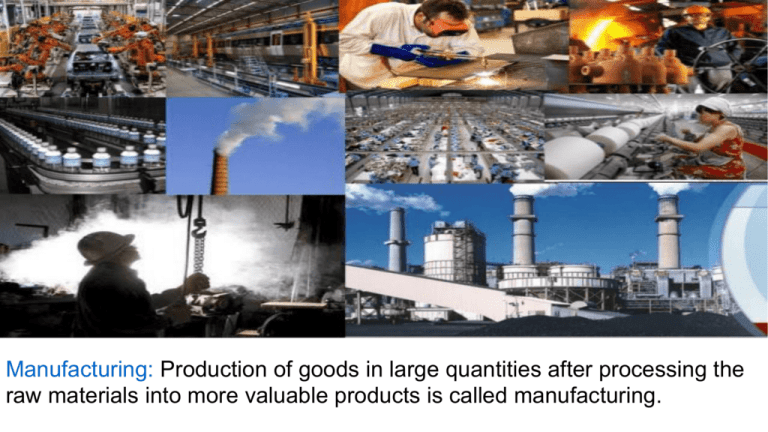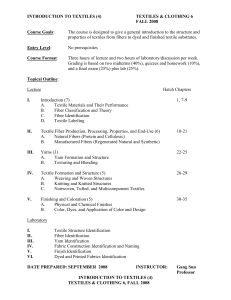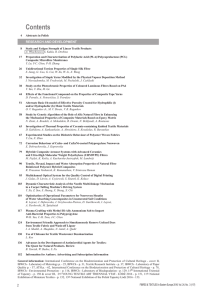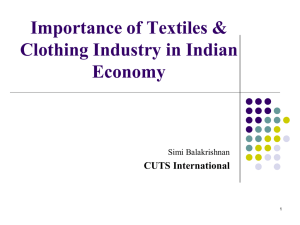File
advertisement

Manufacturing: Production of goods in large quantities after processing the raw materials into more valuable products is called manufacturing. • A COUNTRY WITH HIGH LEVEL OF MANUFACTURING ACTIVITIES BECOMES PROSPEROUS Contribution of Industry to National Economy The share of manufacturing sector in the GDP (Gross Domestic Product) has been stagnant at 17% over the last two decades. The total contribution of industry to the GDP is 27% out of which 10% comes from mining, quarrying, electricity and gas. The growth of the manufacturing sector had been 7% in the last decade. Since 2003, the growth rate has been 9 to 10% per annum. The desired growth rate over the next decade is 12%. The National Manufacturing Competitiveness Council (NMCC) has been set with the objectives of improving productivity through proper policy interventions by the government and renewed efforts by the industry. Industrial Location Some of the factors which affect the industrial location are as follows Sometimes, industries are located in or near cities. Cities provide markets and also provide services like banking, insurance, transport, labour, consultants, etc. Many industries tend to come together to make use of the advantages of an urban centre. Such centre is then called as agglomeration economy. In the pre-independence period, most of the manufacturing units were located in places which were near the ports, e.g. Mumbai, Kolkata, Chennai, etc. As a result, these belts developed as industrial urban centres surrounded by huge agricultural rural hinterland. According to their main role: Basic or Key Industries: These industries supply their products or raw materials to manufacture other goods, e.g. iron and steel, copper smelting, aluminum smelting. Consumer Industries: These industries produce goods which are directly used by consumers, e.g. sugar, paper, electronics, soap, etc. On the basis of capital investment: Small Scale Industry: If the invested capital is upto Rs. one crore, then the industry is called a small scale industry. Large Scale Industry: If the invested capital is more than Rs. one crore, then the industry is called a large scale industry. •Private Sector: These industries are owned and operated by individuals or a group of individuals, e.g. TISCO, Reliance, Mahindra, etc. •Public Sector: These industries are owned and operated by government agencies, e.g. SAIL, BHEL, ONGC, etc. •Joint Sector: These industries are jointly owned by the government and individuals or a group of individuals, e.g. Oil India Limited. •Cooperative Sector: These industries are owned and operated by the producers or suppliers of raw materials, workers or both. The resources are pooled by each stakeholder and profits or losses are shared proportionately. AMUL which is milk cooperative is a good example. The sugar industry in Maharashtra is another example. Based on the bulk and weight of raw materials and finished goods: Heavy Industries: Iron and steel. Light Industries: Electronics Textile Industry The textile industry contributes 14% to industrial production in India. In terms of employment generation, this industry is the second largest after agriculture. 35 million persons are directly employed in the textiles industry in India. The contribution of textiles industry to GDP is 4%. This is the only industry in the country which is self-reliant and complete in the value chain. Cotton textiles were traditionally produced with hand spinning and handloom weaving techniques. Power-looms came into use after the 18th century. During the colonial period, the competition of mill-made cloth from England destroyed the Indian textiles industry. At present, there are 1600 cotton and synthetic textile mills in India. Almost 80% of them are in the private sector. The rest are in the public sector and cooperative sector. Additionally, there are several thousand small factories with four to ten looms. Production of Fabrics in India 2009 Mills 3.3 Powerlooms (in Hosiery) 84.1 Handlooms 11.3 Others 1.3 Total 100% 2010 3.5 84.1 11.1 1.3 100%











